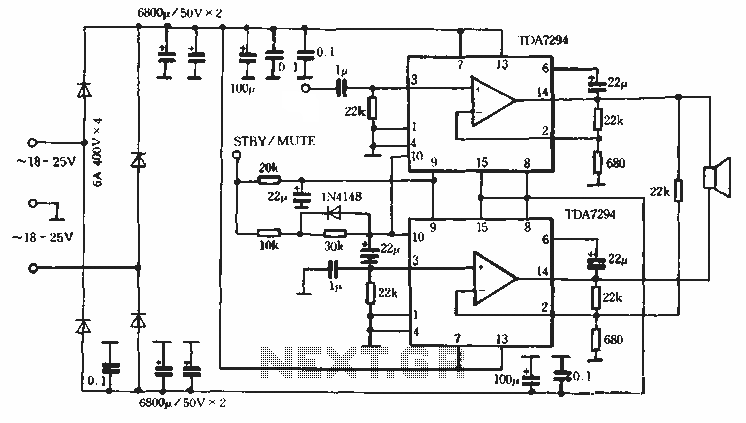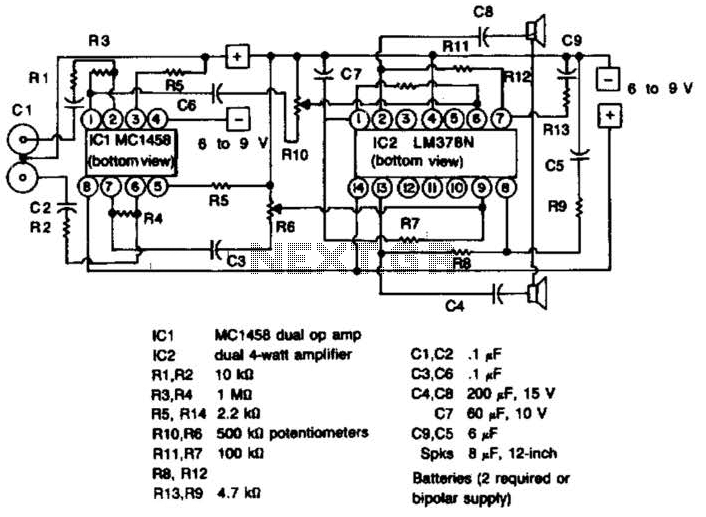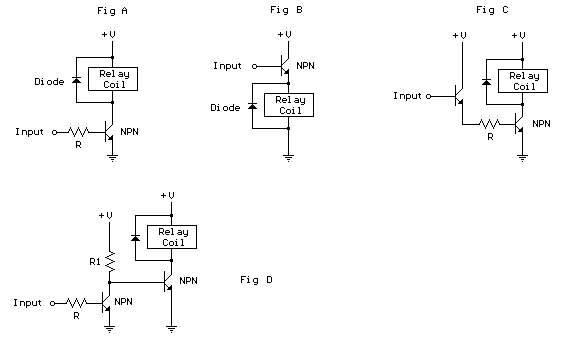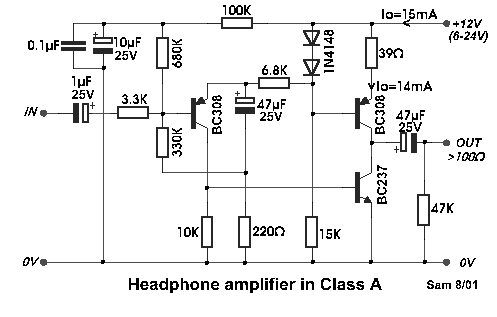
Blocking material monitoring circuit
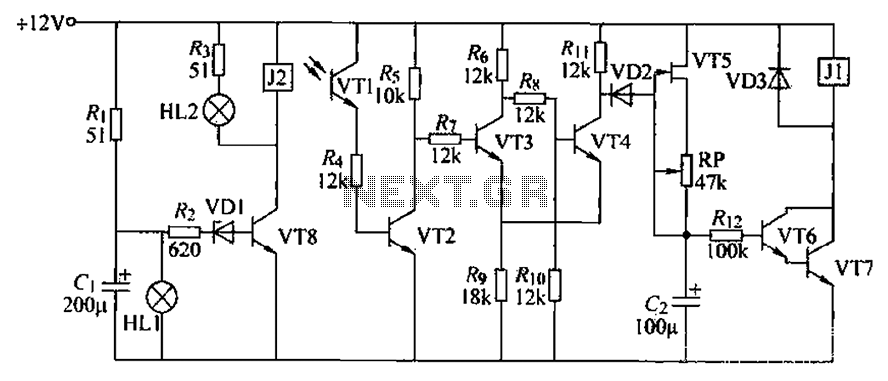
A blocking material monitoring circuit is presented. When the optical path is obstructed by the material, the phototransistor VT1 turns off, which subsequently turns off transistors VT2, VT3, and VT4. This arrangement is coupled to a flip-flop configuration. When the state of VT3 and VT4 is off, diode VD2 cannot be activated, leading to the disconnection of two groups comprising bipolar transistor VT5 and potentiometer RP, which together form a constant current source. This setup charges capacitor C2 until the voltage rises to a specific threshold, at which point transistors VT6 and VT7 are turned on. Relay J1 is activated, allowing for an external control circuit or an alarm to be triggered. If the voltage does not reach the required level, VT6 remains non-conductive. When the optical path is clear, the circuit resets to its stable state with VT3 and VT4 conducting, allowing VD2 to conduct, while capacitor C2 is clamped to a low potential, and relay J1 is deactivated. The circuit is designed to allow for maximum time before an alarm is triggered in the event of a short-circuit condition. Transistor VT8 is used in an automatic negotiation alarm circuit. Component selection and configuration are as follows: VT1 should be a 3DU5, VT2 through VT4 should be 3DG6, with beta values for the transistors ranging from 50 to 80. VT7 and VT8 can be selected from 3DG12 or 3DK4, with low values between 40 and 50. Relays J1 and J2 should be JQX-4F type or other sensitive relays. During testing, light should shine on VT1 and VT3, causing relay J1 to be released. If this does not occur, increasing the value of transistor VT2 (for instance, using a 100-fold increase) may be necessary. If relay J1 does not activate for an extended period when the light path is blocked, a small resistance can be introduced.
The blocking material monitoring circuit operates on the principle of detecting interruptions in an optical path using a phototransistor as the primary sensing element. Upon detection of a blockage, the circuit transitions through a series of states that control the operation of additional transistors and relays to signal an alarm condition. The use of a flip-flop configuration ensures that the state of the circuit is maintained even after the initial trigger condition (blockage) has been removed.
The choice of components is critical for optimal performance; transistors with a beta range of 50-80 are suitable for ensuring adequate current amplification. The constant current source formed by VT5 and the potentiometer RP is pivotal for the reliable charging of capacitor C2, which serves as a timing element in the circuit. The voltage across C2 must reach a specific threshold to activate the subsequent transistors VT6 and VT7, thus engaging the relay J1 for alarm signaling.
In practical applications, the circuit can be adjusted for sensitivity by modifying the value of the potentiometer RP or the resistance in series with the phototransistor. This allows for customization based on the specific requirements of the monitoring environment. Testing and debugging procedures are essential for ensuring the circuit functions as intended, particularly regarding the responsiveness of the relay when the optical path is obstructed. The integration of an automatic negotiation circuit with VT8 adds a layer of sophistication, allowing for dynamic response to varying conditions in the monitored environment. Overall, this circuit design provides an effective solution for monitoring the presence of blocking materials in various applications. Blocking material monitoring circuit is shown. When the optical path is blocked by the material, the phototransistor VT1 off, off transistor VT2, VT3, VT4 shoot coupled flip-fl op consisting of flip turned into VT3, VT4 off state, diode VD2 can not be turned on by the two groups are summarized di pole tube VT5 and potentiometer RP CzJ constant current source to charge the C2 voltage rises to a certain value composite pipes VT6, Vr7 turned on. J1 pull, external control circuit or alarm. If the voltage is not raised to make the C2 level VT6 conductive. Optical path through the old man, then flip into steady shot Xiang Tibetan VT3 deadline, VT4 conduction state, VD2 conduction, the capacitor Cz Chih-end clamped to a low potential, Jl not pull.
That can change the whole RP electric road blocking material to allow maximum time (ie, a short circuit is not blocking material alarm). VT8 light auto-negotiation for-profit composed of the alarm circuit. Component selection and commissioning follows. VT1 election 3DU5, VT2 ~ VT4, VT6 into 3DG6, betas between transistors 50-80. VI7 and VT8 selected 3DG12 or 3DK4. Lo values can be between 40-50. Jl and JZ selection JQX-4F type 1ZV relays or other sensitive relays. When debugging, the light shine on VT1 VT3 should deadline, Jl should be released, if not, you can change J9 VT2 large value (such as 100 -fold) transistors.
If the light path blocked Jl not pull a long time, it can be Ru, into a little resistance.
The blocking material monitoring circuit operates on the principle of detecting interruptions in an optical path using a phototransistor as the primary sensing element. Upon detection of a blockage, the circuit transitions through a series of states that control the operation of additional transistors and relays to signal an alarm condition. The use of a flip-flop configuration ensures that the state of the circuit is maintained even after the initial trigger condition (blockage) has been removed.
The choice of components is critical for optimal performance; transistors with a beta range of 50-80 are suitable for ensuring adequate current amplification. The constant current source formed by VT5 and the potentiometer RP is pivotal for the reliable charging of capacitor C2, which serves as a timing element in the circuit. The voltage across C2 must reach a specific threshold to activate the subsequent transistors VT6 and VT7, thus engaging the relay J1 for alarm signaling.
In practical applications, the circuit can be adjusted for sensitivity by modifying the value of the potentiometer RP or the resistance in series with the phototransistor. This allows for customization based on the specific requirements of the monitoring environment. Testing and debugging procedures are essential for ensuring the circuit functions as intended, particularly regarding the responsiveness of the relay when the optical path is obstructed. The integration of an automatic negotiation circuit with VT8 adds a layer of sophistication, allowing for dynamic response to varying conditions in the monitored environment. Overall, this circuit design provides an effective solution for monitoring the presence of blocking materials in various applications. Blocking material monitoring circuit is shown. When the optical path is blocked by the material, the phototransistor VT1 off, off transistor VT2, VT3, VT4 shoot coupled flip-fl op consisting of flip turned into VT3, VT4 off state, diode VD2 can not be turned on by the two groups are summarized di pole tube VT5 and potentiometer RP CzJ constant current source to charge the C2 voltage rises to a certain value composite pipes VT6, Vr7 turned on. J1 pull, external control circuit or alarm. If the voltage is not raised to make the C2 level VT6 conductive. Optical path through the old man, then flip into steady shot Xiang Tibetan VT3 deadline, VT4 conduction state, VD2 conduction, the capacitor Cz Chih-end clamped to a low potential, Jl not pull.
That can change the whole RP electric road blocking material to allow maximum time (ie, a short circuit is not blocking material alarm). VT8 light auto-negotiation for-profit composed of the alarm circuit. Component selection and commissioning follows. VT1 election 3DU5, VT2 ~ VT4, VT6 into 3DG6, betas between transistors 50-80. VI7 and VT8 selected 3DG12 or 3DK4. Lo values can be between 40-50. Jl and JZ selection JQX-4F type 1ZV relays or other sensitive relays. When debugging, the light shine on VT1 VT3 should deadline, Jl should be released, if not, you can change J9 VT2 large value (such as 100 -fold) transistors.
If the light path blocked Jl not pull a long time, it can be Ru, into a little resistance.
